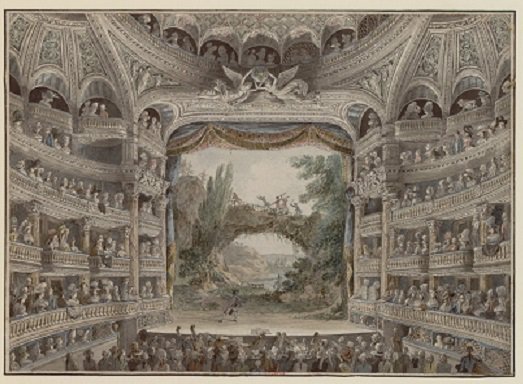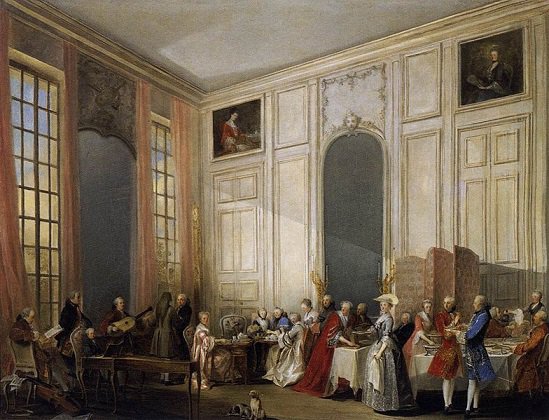Though not officially the capital of France in the eighteenth century — Louis XIV had moved the court to Versailles in 1682 — Paris was nevertheless the intellectual and cultural heart of the country and from mid-century the centre of eighteenth-century Enlightenment thought; Diderot and d’Alembert’s Encyclopédie, ou dictionnaire raisonné des sciences, des arts et des métiers was published there between 1751 and 1772 (with supplemental volumes and indexes to 1780). The chief intellectual and cultural institutions were the Académie Royale de Peinture et de Sculpture (founded 1648), the Académie Royale de Danse (1661), the Académie des Sciences (1666), the Académie Royale de Musique (for opera, 1669), the Académie Royale d'Architecture (1671) and the Comédie-Française (1680). Concerts were mainly — though not exclusively — given by the Concert Spirituel (founded 1725). A distinguishing feature of Parisian musical life from the 1750s through the 1770s was the ongoing controversy, both polemically and in performance, between adherents of French opera and those of Italian opera.

Meunier, Performance at the Comédie-Française, eighteenth century
An overview of Parisian musical life at the time of Mozart’s first visit to Paris in the autumn and winter of 1763-1764, is given in Joseph de La Porte, Les Spectacles de Paris, ou Suite du Calendrier historique et chronologique des theatres . . . pour l’Année 1763 (Paris, n.d.), n.p.:
Jours De Spectacle
Le Concert Spirituel n’est ouvert qu’aux grandes Fêtes, & pendant certains jours du Carême, où les autres Spectacles sont fermés.
On ne donne l’Opéra que trois fois la semaine, depuis le Jeudi qui precede la Fête de l’Ascension jusqu’au Jeudi d’après la S. Martin; sçavoir, le Dimanche, le Mardi & le Vendredi: mais c’est le Vendredi sur-tout qu’on voit jouer les bons Acteurs. Il y a Bal à l’Opéra tous les Dimanches depuis le jour de S. Martin jusqu’au premier Décembre: tems de l’Avent, & depuis le jour des Rois jusqu’à la fin du Carnaval, pendant lequel tems on en donne plusieurs fois la semaine. Ce Bal commence à minuit, & finit à 7 heures du matin.
Les trois jours où il y a le plus de monde à la Comédie Françoise, sont le Lundi, le Mercredi & le Samedi. C’est pour ces jours-là qu’on reserve les meilleures Piéces, ou les Pieces Nouvelles. Les autres jours, le Spectacle est moins fréquenté, excepté le Dimanches, où il y a aussi beaucoup de people.
Les beaux jours pour la Comédie Italienne, sont les Lundis, les Jeudis & les Samedis. Les Dimanches sont encore des jours où l’on donne de bonnes Piéces, & où le Spectacle est fréquenté.
Pendant le tems des Foires de S. Germain & de S. Laurent, c’est-à-dire, pendant les mois de Février, Mars, Avril, Juillet, Août & Septembre, tous les jour il y a Spectacle à la Foire. On y voir des Pantomimes, des Danseurs de Corde, des Voltigeurs, des Sauteurs, des Marionnettes, &c.
Schedule of shows
The Concert Spirituel performs only on major feasts and during certain days of Lent when the other shows are closed.
The Opera plays only three times a week, from the Thursday preceding the Feast of Ascension to the Thursday after S. Martin; that is, Sundays, Tuesdays, and Fridays, but it is on Fridays most of all that one can see the best actors. There are balls at the Opera every Sunday from the feast of S. Martin until the first of December during Advent, and from Epiphany until the end of the carnival, during which they are given several times a week. Balls begin at midnight and finish at 7 o'clock in the morning.
The three busiest days at Comédie Française are Mondays, Wednesdays & Saturdays, which are reserved for the best or new pieces. On other days, the [Comédie] is less busy, except Sundays when there are also many people.
The best days for the Comédie Italienne are Mondays, Thursdays & Saturdays. Sundays are also the days when good pieces are given, and when the [theatre] is well-attended.
There is a show every day during the time of the fairs of S. Germain & S. Laurent, that is to say, during the months of February, March, April, July, August & September. One sees pantomimes, rope dancers, exhibitions of sharp-shooters, acrobats, marionettes & c.
- Mozart Relevance
-
During the ‘Grand Tour’ of 1763-1766, the Mozarts were in Paris from 18 November-24 December 1763, from 8 January to 9 April 1764 and from 10-17 May and 2 June-8 July 1766; their chief sponsor was the expatriate German diplomat and writer Friedrich Melchior Grimm. On Christmas Eve 1763, they traveled to Versailles and on New Year’s Day attended a gala court evening; on 10 March and 9 April 1764, Wolfgang and Nannerl gave concerts at the theatre of M. Félix in the rue et porte St.-Honoré. Two sets of accompanied sonatas by Mozart, K6-7 and K8-9, were published that spring as his opuses I and II. In 1777, Mozart quit Salzburg court service and traveled with his mother first to Mannheim and then to Paris, seeking gainful employment. He arrived at Paris on 23 March 1778. Joseph Legros, director of the Concert Spirituel, commissioned a symphony (K297) from him that was first performed on 18 June and, according to Mozart, a sinfonia concertante for winds (K297B) that is now lost and apparently was not performed. He wrote a concerto for flute and harp (K299) for Adrien-Louis de Bonnières, Duc de Guines, as well as ballet music (K299b) for J.-G. Noverre’s Les petits riens, which was performed at Académie Royal de Musique on 11 June, and eight movements for a Miserere by Ignaz Holzbauer (K297a, lost).
Mozart claimed in a letter of 14 May 1778 to have been offered the organist’s position at Versailles:
- Rodolphe [Jean Joseph Rodolphe
(1730-1812), horn player] . . . is in the royal service here and is a very good
friend of mine; he understands composition thoroughly and writes well. He has
offered me the post of organist at Versailles, if I will accept it. The salary
is 2000 livres a year, but I should have to spend six months at Versailles and
the other six in Paris, or wherever I like. I do not think that I shall accept
it, but I have yet to hear the advice of some good friends on the subject.
After all, 2000 livres is not such a big sum. It would be so in German money, I
admit, but here it is not.
Nothing came of this proposal and no other post was forthcoming. Mozart’s mother died in Paris on 3 July and he left the city on 26 September. Other works by him composed there include the keyboard sonata K310 and the accompanied sonatas K304 and K306; the accompanied sonatas were published in Paris later that year, after Mozart had left the city.

Michel-Barthélémy Ollivier, Afternoon Tea at the Temple, 1766 (Musée National du Château, Versailles)
- Rodolphe [Jean Joseph Rodolphe
(1730-1812), horn player] . . . is in the royal service here and is a very good
friend of mine; he understands composition thoroughly and writes well. He has
offered me the post of organist at Versailles, if I will accept it. The salary
is 2000 livres a year, but I should have to spend six months at Versailles and
the other six in Paris, or wherever I like. I do not think that I shall accept
it, but I have yet to hear the advice of some good friends on the subject.
After all, 2000 livres is not such a big sum. It would be so in German money, I
admit, but here it is not.
- Category/Role
- City
- Location
- France
Pages referencing Paris:
1763-1778: The Louvre colonnade
Souvenirs purchased or acquired by the Mozarts that are lost
The Mozarts as Collectors of Souvenirs
A Portrait of Mozart, his sister Nannerl and Leopold Mozart Performing
W. A. Mozart, God is our Refuge K20
Surviving Souvenirs 1: Engravings of London purchased by, or given to, the Mozarts, 1764-5